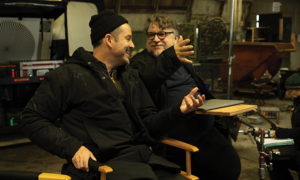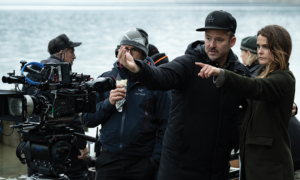Antlers is director Scott Cooper’s first foray into horror filmmaking and his fifth feature after Crazy Heart, Hostiles, Out Of The Furnace and Black Mass. A loose adaptation of Channel Zero creator, Nick Antosca’s short story, ‘The Quiet Boy’, Cooper was guided by a hands-on producer and mentor in the form of monster maestro, Guillermo del Toro.
“When Guillermo asked me to consider rewriting the screenplay and directing it, he told me: ‘Your last three films have been horror films and nobody knows it!’ In a sense he is completely right. For me personally, horror is a genre that allows me to continue to explore the furthest and darkest reminisces of the human experience. You get the type of rush from a horror film as a viewer, that you don’t get from any other type of film. I feel at times, I have a duty as a storyteller to grip the audience by the throat and never let go and horror is a genre in which to do that.”

Keri Russell and Jesse Plemons star alongside talented young newcomer, Jeremy T Thomas who plays, Lucas, a school boy who is showing signs of malnutrition, abuse and neglect. Russell, as his teacher Julia, investigates his family life, while her brother and sheriff Paul (Plemons) gets in over his head when a vicious entity is unleashed on his small rural hometown.
Plemons is an actor who Cooper has worked with previously, and who he chose, because of his everyman qualities, “Jesse is one of the best actors of his generation. He represents an everyman in America in the best of ways. He has such great countenance that you believe him in every scenario. He plays a younger brother who harbours resentment towards his sister, but he’s also a sheriff who is completely out of his depth.”
Cooper takes the Wendigo mythology and uses it as a metaphor to explore themes of addiction and the lasting effects of colonisation on the indigenous population in the USA. It’s something which he has explored in his previous work with revisionist western, Hostiles.
Native American actor, Graham Green also appears in the film, and is someone who Cooper spoke at length with about these issues: “Graham is one of our great indigenous actors and I thought he could represent the historical trauma of Native Americans in a tragic but graceful and powerful way. He and I spoke about what it means to be an indigenous person, what it means that this historical trauma both in the US and Canada has continued since people first came to our shores. If you’ve spent any time on the reservations, as I have, it’s heart breaking. We as Americans aren’t doing nearly enough to help the women, men and children who live on these reservations. That’s one of the many things that keep me up at night.”
He decided to keep the horror grounded in reality, and cites films like Nicolas Roeg’s Don’t Look Now, William Friedkin’s The Exorcist and John Carpenter’s Halloween as touchstones for the kind of tone he wanted to set. “I like ambiguity in my films, I think demystifying everything is not the key to a successful story. I wanted to pose questions for the audience to come up with their own answers. I wanted it to be lightly drawn but pointed enough so the audience could take something from it that maybe I wasn’t so explicit with, but is implied. I wanted to discuss the horrors that we as Americans are experiencing. In America, we are suffering an addiction crisis, and one if we don’t effectively and efficiently address it as the public health issue it is, we’re going to continue to see drug epidemic after drug epidemic. I set this in a rural town for a reason, because those are the ones that are most being ravaged. Essentially Americans are dying from what we call ‘deaths of despair’.”

Bursts of disturbing gore and the occasional jump scare are effectively handled. The creation of the monster was seeded from ideas concerning the pillaging of natural resources and the impact of environmental disaster.
“I worked with some Native American advisors to better understand the Wendigo,” explains Cooper.
A mythological beast born out of desperate times that turned to cannibalism and which in the film, feeds on the despair and flesh of the vulnerable. “Guillermo and I, and his regular team, created the Wendigo’s look. We wanted it to feel like it was born out of a mine, like an iron or coal mine, something that has embers. Because we’re using it as a metaphor for avenging nature, among other things, we wanted to include all of those things that you would believe would come out of a mine because they strip mountain tops, they build these mines and take all the resources.”
Certain visuals recall del Toro’s early work from The Devil’s Backbone, with sickly, pale and innocent children anxiously waiting for help and tragically affected by things that are out of their control. The abusive family elements are not only prevalent in young Lucas’ story but also presented as friction between Julia and her brother Paul, which was something Cooper added in his rewrite. “I wanted the film to feel as grounded as possible while also using light supernatural feelings. I wanted the story to work even if there was no Wendigo. Which is difficult to do, because you’re taking a drama about the breakdown of the nuclear family, addiction, child endangerment, sibling separation, and then you’re also drawing to make a horror film, and on top of that a monster film.
“Any time I had anything that dealt with the supernatural I would always ask Guillermo for his opinion. He let me make the film I wanted. Any questions I had [I’d ask him because] who better to learn from than Guillermo? Monsters are his life. He has more connection to monsters in films and just in his general everyday life than I ever will.”
Antlers is out at cinemas now.
